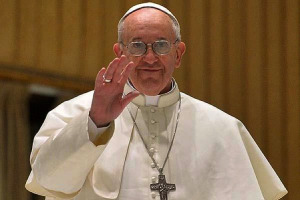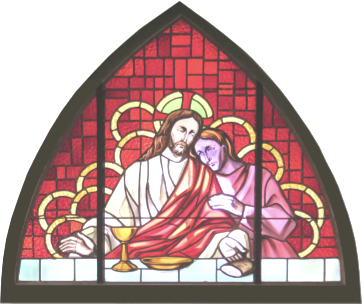Messages of Mercy
By Lorraine Vincent
February 1, 2016
Download a printable pdf version
Jubilee Year of Mercy
Pope Francis, throughout his pontificate has been emphasizing the need for mercy throughout the world. He proclaimed that this is the Jubilee Year of Mercy, beginning December 8, 2015 and extending to November 20, 2016. He continues to stress that we must have mercy on people in need, according to the will of God. Some people refer to him as the Mercy Pope.
Jubilee Indulgence of the Year of Mercy
 Pope Francis also has instituted a special Jubilee Indulgence of the Year of Mercy. Our Catholic Church can grant indulgences. Our time spent in Purgatory, after our death, can be reduced or removed with indulgences that are concrete steps toward conversion here on earth. The earning of indulgences cannot be only external gestures, done superficially, but must be a process of interior growth toward actual detachment from sin. Therefore, Catholics must follow certain prescribed conditions set down by the Church. Our Catechism of the Catholic Church offers lots of information on indulgences in numbers 1471, 1472, 1478, and 1479.
Pope Francis also has instituted a special Jubilee Indulgence of the Year of Mercy. Our Catholic Church can grant indulgences. Our time spent in Purgatory, after our death, can be reduced or removed with indulgences that are concrete steps toward conversion here on earth. The earning of indulgences cannot be only external gestures, done superficially, but must be a process of interior growth toward actual detachment from sin. Therefore, Catholics must follow certain prescribed conditions set down by the Church. Our Catechism of the Catholic Church offers lots of information on indulgences in numbers 1471, 1472, 1478, and 1479.
Pastoral Directives for the Archdiocesan Celebration of the Jubilee Year of Mercy
Our Archdiocese of Regina, through the authority of Archbishop Daniel Bohan (now deceased) and Fr. James Owolagba, Chancellor, has authorized means for the faithful to receive the Jubilee Indulgence of the Year of Mercy. The following are excerpts from their document entitled, “Pastoral Directives for the Archdiocesan Celebration of the Jubilee Year of Mercy”.
- All those who pass through the Holy Doors of Holy Rosary Cathedral, Regina, and the co-cathedral at Our Lady of Assumption, Gravelbourg, and are seeking God’s mercy through the sacraments of Reconciliation and Eucharist, who show God’s love and forgiveness and who show deep desire for true conversion and who pray the Apostles Creed and for the Pope’s intention, would be granted the Jubilee Indulgence of the Year of Mercy as declared by Pope Francis.
- Likewise, this Indulgence may be obtained by all pilgrims who during the Year of Mercy visit any of the Shrines located in the Archdiocese of Regina.
- Those for whom, for various reasons, it will be impossible to enter the Holy Doors or visit a shrine, particularly the sick and people who are elderly and alone or are in nursing homes or in prison, if they receive Holy Communion or attend Holy Mass and community prayer, even though by means of the various communication media, it will be for them the means of obtaining the Jubilee Indulgence.
If you are interested in obtaining more information on indulgences, go back to “Columnists” and you will find “Indulgences” a detailed article that I wrote, dated June 7, 2015.
The Divine Mercy Message
St. John Paul II has also been called the Mercy Pope. This is because he was instrumental in spreading the Devotion to the Divine Mercy throughout our universal Catholic Church. Before he was elected Pope, he was Cardinal Karol Wojtyla, Archbishop of Cracow, Poland, a great man of mercy. Cardinal Wojtyla became familiar with the life and diary of Sister Faustina Kowalska of the Congregation of the Sisters of Our Lady of Mercy in Warsaw, Poland. He was convinced of her holiness. She lived from 1905 to 1938. After he was elected Pope John Paul II, he canonized her as St. Maria Faustina Kowalska of the Blessed Sacrament. It all happened this way…
At the age of 20 years old, Helena Kowalska entered the convent of the Congregation of the Sisters of Our Lady of Mercy in Warsaw, Poland. Then on April 30, 1926, Helena took the veil and received the name Sister Maria Faustina. In those early days Sister Faustina often heard the voice of Jesus and also saw Him speaking to her. She loved Jesus immensely. She also saw and received help from the Blessed Virgin Mary.
In the following years, Jesus appeared countless times to St. Faustina. Jesus told her that He is the Divine Mercy and she was to be His secretary. She was to keep a dairy to write down everything He said, in order to spread His message of mercy. St. Faustina called her diary Divine Mercy in My Soul. St. Faustina’s diary was published with her thoughts and visions numbered separately, for our reference. In her diary entry number 1732, Jesus said, “From her will come the spark that will prepare the world for My final coming.” This diary has a wealth of spiritual guidance about our Catholic faith. For example, we can read about the value of Holy Mass, the Sacraments, the value of redemptive human suffering, the immeasurable mercy of Jesus to repentant souls, prayers to the Divine Mercy and information on Divine Mercy Sunday.
God chose another great man, Fr. Michal Sopocko, now proclaimed Blessed, to be her confessor and spiritual director, and assist her in the accomplishment of her prophetic mission. The Divine Mercy Message, the Image and the Divine Mercy Chaplet, began to spread after her death at 33 years of age.
Cardinal Karol Wojtyla, Archbishop of Cracow, Poland, started her Process of Beatification by completing the diocesan information process and sending the documentation to Rome on September 20, 1967. Cardinal Karol Wojtyla was later elected Pope John Paul II. In 1980 he released his encyclical letter “Dives in Misericordia, The Mercy of God”. Then he canonized St. Faustina Maria Kowalska, to be the first saint of the year 2000. At the canonization ceremony he introduced the world to the Devotion to the Divine Mercy. Also, he proclaimed that Divine Mercy Sunday be celebrated on the first Sunday after Easter throughout the universal Church, to draw people to the merciful Heart of Jesus.
Now, the whole world has Christ’s great message of mercy and two wonderful saints to intercede for us—St. Faustina and St. John Paul II. We also have our current man of mercy, Pope Francis. Let us not forget to pray for him and for his intentions.

